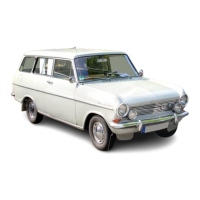The vehicle owner who does his or her own maintenance according
to the recommended service schedules should not have to use this
section of the manual very often. Modern component reliability is such
that, provided those items subject to wear or deterioration are
inspected or renewed at the specified intervals, sudden failure is
comparatively rare. Faults do not usually just happen as a result of
sudden failure, but develop over a period of time. Major mechanical
failures in particular are usually preceded by characteristic symptoms
over hundreds or even thousands of miles. Those components which
do occasionally fail without warning are often small and easily carried
in the vehicle.
With any fault-finding, the first step is to decide where to begin
investigations. Sometimes this is obvious, but on other occasions, a
little detective work will be necessary. The owner who makes half a
dozen haphazard adjustments or replacements may be successful in
curing a fault (or its symptoms), but will be none the wiser if the fault
recurs, and ultimately may have spent more time and money than was
necessary. A calm and logical approach will be found to be more
satisfactory in the long run. Always take into account any warning
signs or abnormalities that may have been noticed in the period
preceding the fault - power loss, high or low gauge readings, unusual
smells, etc - and remember that failure of components such as fuses or
spark plugs may only be pointers to some underlying fault.
The pages which follow provide an easy-reference guide to the more
common problems which may occur during the operation of the
vehicle. These problems and their possible causes are grouped under
Fault diagnosis REF•11
REF
Engine
mm Engine fails to rotate when attempting to start
mm Engine rotates, but will not start
mm Engine difficult to start when cold
mm Engine difficult to start when hot
mm Starter motor noisy or excessively-rough in engagement
mm Engine starts, but stops immediately
mm Engine idles erratically
mm Engine misfires at idle speed
mm Engine misfires throughout the driving speed range
mm Engine hesitates on acceleration
mm Engine stalls
mm Engine lacks power
mm Engine backfires
mm Oil pressure warning light illuminated with engine running
mm Engine runs-on after switching off
mm Engine noises
Cooling system
mm Overheating
mm Overcooling
mm External coolant leakage
mm Internal coolant leakage
mm Corrosion
Fuel and exhaust systems
mm Excessive fuel consumption
mm Fuel leakage and/or fuel odour
mm Excessive noise or fumes from exhaust system
Clutch
mm Pedal travels to floor - no pressure or very little resistance
mm Clutch fails to disengage (unable to select gears)
mm Clutch slips (engine speed increases, with no increase in vehicle
speed)
mm Judder as clutch is engaged
mm Noise when depressing or releasing clutch pedal
Manual gearbox
mm Noisy in neutral with engine running
mm Noisy in one particular gear
mm Difficulty engaging gears
mm Jumps out of gear
mm Vibration
mm Lubricant leaks
Automatic transmission
mm Fluid leakage
mm Transmission fluid brown, or has burned smell
mm General gear selection problems
mm Transmission will not downshift (kickdown) with accelerator fully
depressed
mm Engine will not start in any gear, or starts in gears other than Park
or Neutral
mm Transmission slips, shifts roughly, is noisy, or has no drive in
forward or reverse gears
Driveshafts
mm Clicking or knocking noise on turns (at slow speed on full-lock)
mm Vibration when accelerating or decelerating
Braking system
mm Vehicle pulls to one side under braking
mm Noise (grinding or high-pitched squeal) when brakes applied
mm Excessive brake pedal travel
mm Brake pedal feels spongy when depressed
mm Excessive brake pedal effort required to stop vehicle
mm Judder felt through brake pedal or steering wheel when braking
mm Brakes binding
mm Rear wheels locking under normal braking
Suspension and steering systems
mm Vehicle pulls to one side
mm Wheel wobble and vibration
mm Excessive pitching and/or rolling around corners, or during
braking
mm Wandering or general instability
mm Excessively-stiff steering
mm Excessive play in steering
mm Lack of power assistance
mm Tyre wear excessive
Electrical system
mm Battery will not hold a charge for more than a few days
mm Ignition/no-charge warning light remains illuminated with engine
running
mm Ignition/no-charge warning light fails to come on
mm Lights inoperative
mm Instrument readings inaccurate or erratic
mm Horn inoperative, or unsatisfactory in operation
mm Windscreen/tailgate wipers inoperative, or unsatisfactory in
operation
mm Windscreen/tailgate washers inoperative, or unsatisfactory in
operation
mm Electric windows inoperative, or unsatisfactory in operation
mm Central locking system inoperative, or unsatisfactory in operation
Introduction

